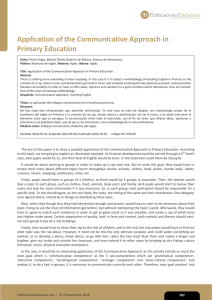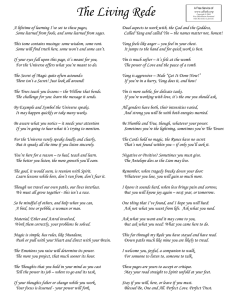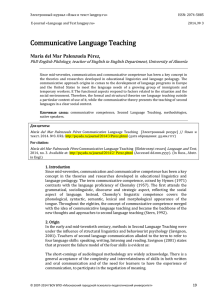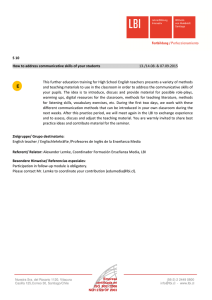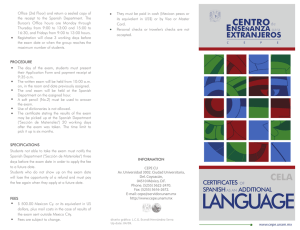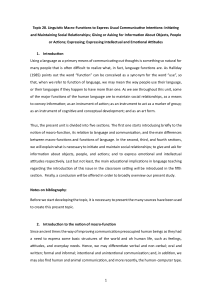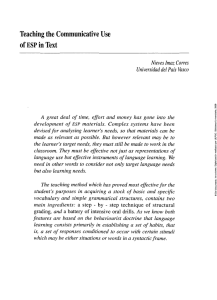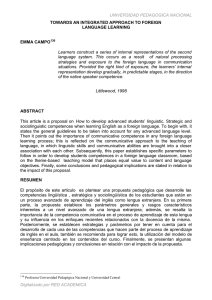From a relational and communicative conception of God in Tertullian to an anthropology of communication
Anuncio
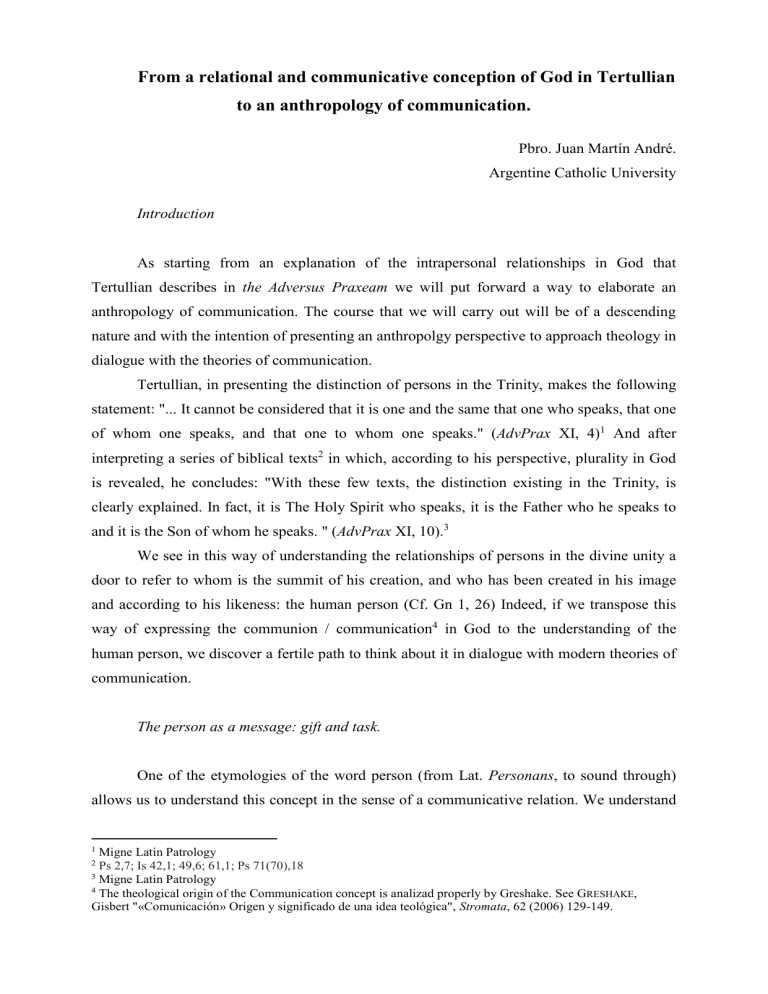
From a relational and communicative conception of God in Tertullian to an anthropology of communication. Pbro. Juan Martín André. Argentine Catholic University Introduction As starting from an explanation of the intrapersonal relationships in God that Tertullian describes in the Adversus Praxeam we will put forward a way to elaborate an anthropology of communication. The course that we will carry out will be of a descending nature and with the intention of presenting an anthropolgy perspective to approach theology in dialogue with the theories of communication. Tertullian, in presenting the distinction of persons in the Trinity, makes the following statement: "... It cannot be considered that it is one and the same that one who speaks, that one of whom one speaks, and that one to whom one speaks." (AdvPrax XI, 4)1 And after interpreting a series of biblical texts2 in which, according to his perspective, plurality in God is revealed, he concludes: "With these few texts, the distinction existing in the Trinity, is clearly explained. In fact, it is The Holy Spirit who speaks, it is the Father who he speaks to and it is the Son of whom he speaks. " (AdvPrax XI, 10).3 We see in this way of understanding the relationships of persons in the divine unity a door to refer to whom is the summit of his creation, and who has been created in his image and according to his likeness: the human person (Cf. Gn 1, 26) Indeed, if we transpose this way of expressing the communion / communication4 in God to the understanding of the human person, we discover a fertile path to think about it in dialogue with modern theories of communication. The person as a message: gift and task. One of the etymologies of the word person (from Lat. Personans, to sound through) allows us to understand this concept in the sense of a communicative relation. We understand 1 Migne Latin Patrology Ps 2,7; Is 42,1; 49,6; 61,1; Ps 71(70),18 3 Migne Latin Patrology 4 The theological origin of the Communication concept is analizad properly by Greshake. See GRESHAKE, Gisbert "«Comunicación» Origen y significado de una idea teológica", Stromata, 62 (2006) 129-149. 2 the term “message” as the information that the “transmitter” delivers to the “receiver”. Then, by affirming that the person is a message we assume that his nature is to communicate a form to another one (task), which in our believing perspective comes from God (gift). This divine origin of man is therefore Trinitarian, and we take from Tertullian his interpretation of the diversity of persons in the Trinity as communicative relationships: The Spirit speaks of the Son to the Father. The message is the Son, this is what is spoken of, what is uttered, while the “transmitter” of the message is the Spirit and the “receiver” is the Father. When transposing this scheme to the human person, that is to say to that one who asks "Who am I?", we find as a possible outcome to understand it as a message -form- pronounced by the Spirit that in time is said in front of another. While human life is a gift received by the Triune God, the task of every human being is to become a person - to be a person - that is, to say / tell oneself to another. What is the message ?: The life of Christ displayed in his own life as St. Paul affirms: "It is no longer I who live, but Christ lives in me" (Gal. 2,20).5 To graph this way of understanding the person we suggest the application of the classic communication scheme to it (Jakobson's model)6, extending the notion of the “transmitter” that we understand as a person who receives the life from God. Each person can be defined as a receiver / transmitter of himself, while receiving the life of the Son (message) through the Spirit (grace) and pilgriming to the Father communicating itself before a receiver.7 We will present, assuming the simplification that this implies, the person as a communicative being8 graphing it as a triangular surface: T2 T1 Rn T3 The Church`s Magisterium has defined Christ as “The perfect communicator”. See PONTIFICAL COMMISSION FOR THE MEDIA OF SOCIAL COMMUNICATION, Pastoral Instruction Communio et Progressio, 11. 6 A. PLAZAS, “Grandes pensadores de la comunicación”, La Tadeo 68 (2003), 195. 7 It is worth clarifying that when we affirm that the person "says itself" we assume both verbal and non-verbal language and the possibility of transcendent openness. This is clearly stated by Cecilia Avenatti de Palumbo and Alejandro Bertolini when referring to the writings of Cristophe Lebreton: "it is important to bear in mind that both his words and gestures say much more than what we read at first sight". See C. AVENATTI DEL PALUMBO; A. BERTOLINI, La casa en el Puente. Christophe Lebreton: Huésped de fronteras. Buenos Aires, Agape, 2017, 24. 8 Although their proposal is more holistic we have also been inspired by the studies of Scharer and Hilbertah. See SCHARER, MATTHIAS; HILBERATH, BERN JOCHEN, The practice of Communicative Theology, New York, The Crossroad Publishing Company, 27-32. 5 The flat surface of the triangle represents the person who is a transmitter. In a vertex is the subject that manifests -he speaks- (T1), this is the basic level of communication of the person. The second vertex (T2) represents the degree of consciousness of the person: how much he knows himself, how he interprets his life story, etc. Then, the third vertex9 (T3) symbolizes the life of grace in the person. Each time an individual communicates these three vertices come into play. From this description we will formulate the following hypothesis: A person who manages to integrate in depth these three dimensions will communicate better, and will also communicate better the message that God has inscribed in him, which is Himself. He will become, so as to say , a fuller person. And all this can be analized by the way he communicates. Scope of this proposal We will mention now some perspectives as an outcome of understanding the person as a communicative being. The first is a window to assume communication as a way of accessing the mystery of the person who makes himself known when it is said and when he talks. The second can be an important support to provide an anthropological foundation to the research line of communicative sacramentology opened by Alexandre Ganoczy10 and continued by H. O. Meuffels.11 The third, in line with the previous one, is oriented to the liturgy, since the celebration of the Christian mystery has a fundamental anthropological character, the approaches of the person in a relational sense can be very fruitful, so that the believers and the students of that matter, as they become aware of their personal communicative nature, may participate more actively in the liturgical celebrations and make significant contributions for its renewal. 9 This is the dimension of the person that Teresa de Ávila invites to visit in the dwellings of the interior castle. See A. GANOCZY, An introduction to Catholic Sacramental Theology, Eugene, Wipf & Stock, 2008, 142-182. 11 H.O. MEUFFELS, Kommnikative Sakramententheologie, Herder, 1995. 10
